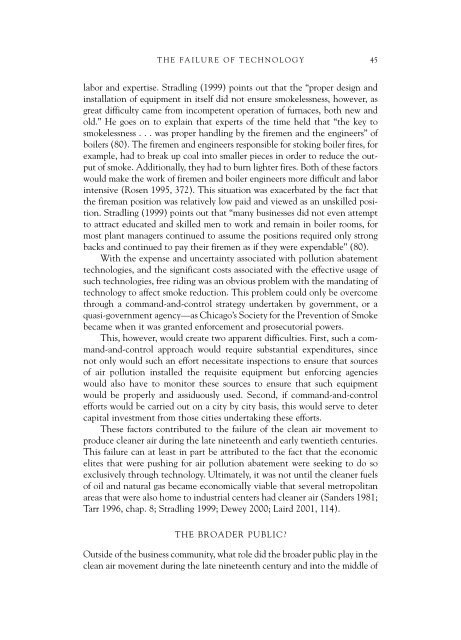GEORGE A. GONZALEZ - fieldi
GEORGE A. GONZALEZ - fieldi
GEORGE A. GONZALEZ - fieldi
Create successful ePaper yourself
Turn your PDF publications into a flip-book with our unique Google optimized e-Paper software.
THE FAILURE OF TECHNOLOGY 45labor and expertise. Stradling (1999) points out that the “proper design andinstallation of equipment in itself did not ensure smokelessness, however, asgreat difficulty came from incompetent operation of furnaces, both new andold.” He goes on to explain that experts of the time held that “the key tosmokelessness ... was proper handling by the firemen and the engineers” ofboilers (80). The firemen and engineers responsible for stoking boiler fires, forexample, had to break up coal into smaller pieces in order to reduce the outputof smoke. Additionally, they had to burn lighter fires. Both of these factorswould make the work of firemen and boiler engineers more difficult and laborintensive (Rosen 1995, 372). This situation was exacerbated by the fact thatthe fireman position was relatively low paid and viewed as an unskilled position.Stradling (1999) points out that “many businesses did not even attemptto attract educated and skilled men to work and remain in boiler rooms, formost plant managers continued to assume the positions required only strongbacks and continued to pay their firemen as if they were expendable” (80).With the expense and uncertainty associated with pollution abatementtechnologies, and the significant costs associated with the effective usage ofsuch technologies, free riding was an obvious problem with the mandating oftechnology to affect smoke reduction. This problem could only be overcomethrough a command-and-control strategy undertaken by government, or aquasi-government agency—as Chicago’s Society for the Prevention of Smokebecame when it was granted enforcement and prosecutorial powers.This, however, would create two apparent difficulties. First, such a command-and-controlapproach would require substantial expenditures, sincenot only would such an effort necessitate inspections to ensure that sourcesof air pollution installed the requisite equipment but enforcing agencieswould also have to monitor these sources to ensure that such equipmentwould be properly and assiduously used. Second, if command-and-controlefforts would be carried out on a city by city basis, this would serve to detercapital investment from those cities undertaking these efforts.These factors contributed to the failure of the clean air movement toproduce cleaner air during the late nineteenth and early twentieth centuries.This failure can at least in part be attributed to the fact that the economicelites that were pushing for air pollution abatement were seeking to do soexclusively through technology. Ultimately, it was not until the cleaner fuelsof oil and natural gas became economically viable that several metropolitanareas that were also home to industrial centers had cleaner air (Sanders 1981;Tarr 1996, chap. 8; Stradling 1999; Dewey 2000; Laird 2001, 114).THE BROADER PUBLIC?Outside of the business community, what role did the broader public play in theclean air movement during the late nineteenth century and into the middle of









